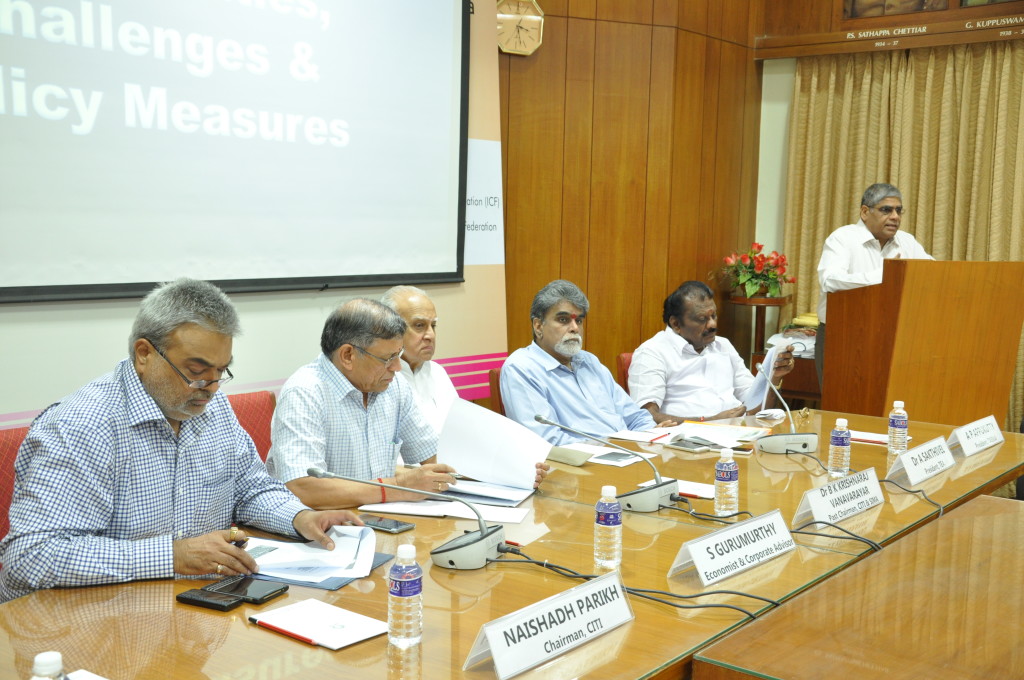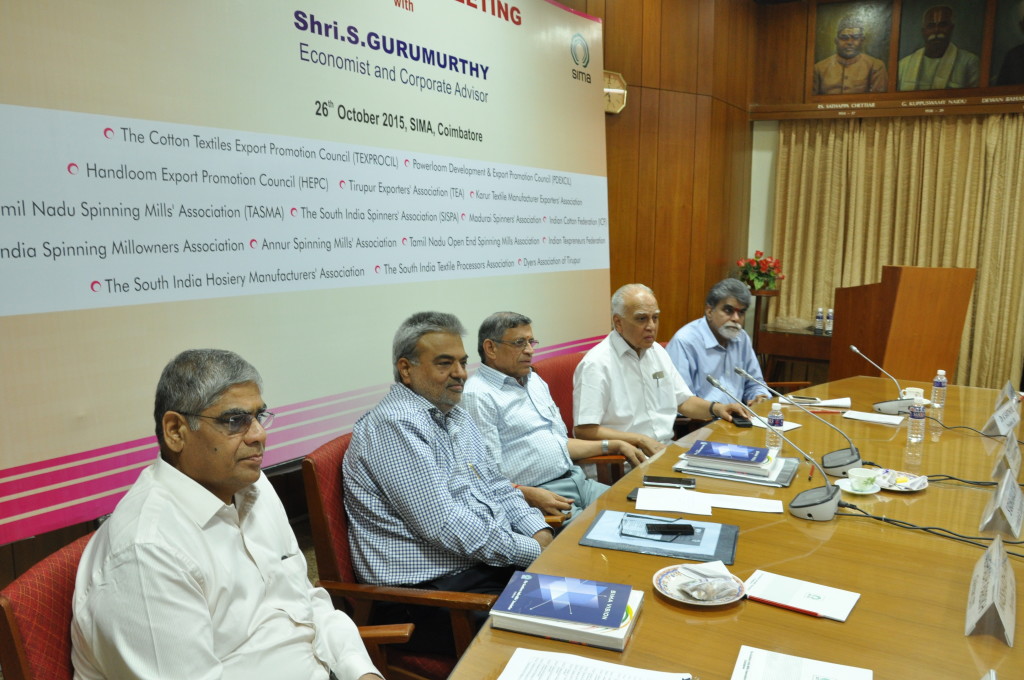The Indian textile industry has been passing through severe recession since April 2014 due to glut in the global market, market access related issues, delay in conclusion of the FTAs, undue delay in disbursement of TUF subsidies, etc. At the request of the Industry Associations, the Ministry of Textiles and Ministry of Commerce & Industry has also been making concerted efforts to revive the industry from recession and seeking various supportive policy measures from the Ministry of Finance and PMO. Though the Central Government has been addressing various macro issues, particularly control of inflation, general economic conditions, infrastructure, ease of doing business measures etc., the second largest employment provider, textile industry, providing jobs to over 105 million people next only to agriculture is yet to be given weightage to enable the textile industry to grab emerging global opportunities.
Recently, the Indian Prime Minister met Mr.Mukesh Ambani and Mr.Kumaramangalam Birla to have detailed discussions on the textile industry. He advised the Chief Economic Advisor to the Government of India, Mr. Arvind Subramanian to study the conditions and discuss with the textile industry. Indian textile industry is facing two major challenges, one on the raw material front and another on market access.
Against this background, The Southern India Mills’ Association (SIMA) took up the initiative and organized an interaction meeting recently with Mr.S.Gurumurthy, renowned Economist and Corporate Advisor by involving all the textile industry Associations representing the whole textile value chain at SIMA premises. The association is making efforts to use the good offices of Mr.S.Gurumurthy to impress upon the Prime Minister and his office.
In a press release issued then, Mr.M.Senthilkumar, Chairman, The Southern India Mills’ Association (SIMA) has stated that the office-bearers and Committee members of around 20 Associations including Confederation of Indian Textile Industry (CITI), the apex body for the entire textile value chain in the nation, Tirupur Exporters Association, Powerloom Development and Export Promotion Council, Tamilnadu Spinning Mills Association, South India Spinners Association, Handloom Export Promotion Council, South India Hosiery Manufacturers Association attended the meeting.
SIMA Chairman has stated that all the Industry Associations have given their inputs to Mr.S.Gurumurthy and requested him to take up the issue with the PM and PMO and impress upon him to come out with slew of policy measures to enable the Indian textile industry to achieve its potential growth rate and achieve a lion’s share in the global textile industry as projected by the international studies including International Textile Manufacturers Federation (ITMF).
Mr.Senthilkumar has stated that India continues to decline in the overall exports for the ninth month and during September 2015 overall exports declined by 24.33%, cotton textiles by 3.58%, textiles and clothing by 5.71% and garment by 12.02%. He has added that the textiles and clothing exports recorded a marginal growth of 0.54% during April to September 2015 when compared to the same period during the previous year resulting in a virtual stagnation while the capacity has been growing steadily due to the announcement of attractive textile policies by various State Governments.
He said that the world trade is undergoing certain structural changes which have severe impact on Indian exports. He pointed out that both cyclical element of lower global demand and changes in the structural demands are affecting the textile exports. The Trans Pacific Partnership (TPP) Agreement entered by various countries recently would conditionally improve following of extant rules conferring origin for intermediate goods such as yarns, fabrics to be produced locally or sourced from signatory countries which would have greater impact on Indian textile exports particularly countries like Vietnam. He said TPP would enable countries like Vietnam to have zero duty access while Indian products would attract 14 to 32% duties.
On the raw material front, SIMA Chairman has stated that the country would need around 20 billion kgs of fibre to achieve the vision of the Prime Minister of 300 billion US $ textile business size by 2020 from the current level of 110 billion US $. He also said that the cotton fibre production which is at 6.7 billion kgs could be increased to 8 billion kgs with right technologies in place and balance 12 billion kgs should be met from manmade fibres and that it is impossible to increase the manufacturing base by five times. The tariff protection given to few indigenous fibre manufacturers should be withdrawn and the fibres be made available at international price to enable the industry to achieve its potential growth rate and grab the global opportunities.
SIMA Chairman has requested Mr.S.Gurumurthy to recommend to the government to:-
Release adequate funds to clear all the pending TUF subsidies to sustain Rs.1.00 lakh crores investments already made,
Provide 3% interest subvention for all textile products till the country achieves the envisaged growth rate in exports,
Provide suitable market specific incentives under MEIS till the FTAs are concluded,
Remove 5% import duty, 4% special additional duty, anti-dumping duty and reduce central excise duty from 12.5% to 6% to make MMF available at international price,
Make Cotton Corporation of India to follow industry-friendly cotton trading policy,
Reduce hank yarn obligation from 40% to 20%,
Reduce number of fabric items covered under Handloom Reservation Act from 11 to 3 or 4,
Direct banks to fully pass on the repo rate reduction benefit to the customers,
Announce stable and win-win strategy policies including the Textile Policy and implementation of GST.
In his presidential address, Dr. B.K.Krishnaraj Vanavarayar, Past Chairman, SIMA and CITI stated that Mr.Gurumurthy is capable of understanding the current scenario of the textile industry and sensitize the government to take necessary action and make the industry vibrant. Mr. Naushad Parikh, Chairman, Confederation of Indian Textile Industry, in his special address stated that there is an urgent need to address the raw material issue, implement direct transfer of cotton subsidy to the farmers to resolve the various issues relating to cotton and also duty structure of manmade fibre. He also said that it is essential for India to negotiate and conclude various FTAs to get better market access.
Dr. A. Sakthivel, President, Tirupur Exporters Association in his address insisted FTAs with EU to double the garments and thereby increase the domestic demand for yarns and fabrics. He also urged to expedite the announcement of interest subvention which has been under active consideration for more than a year to have competitive edge in the open market. Mr. Sakthivel also stressed the need for allocating adequate funds for market development in the overseas.
Mr.A.P.Appukutty, President, Tamil Nadu Spinning Mills Association, Mr.Viking Easwaran, The South India Handloom Manufacturers Association, Mr.P.Elango, Chairman, The South India Textile Processors Association, Mr.C.Varatharajan, President, The South India Spinners’ Association, Mr. M Jayabal, Coordinator, Tamil Nadu Open End Spinning Mills Association, Mr.T.R.Vivekananthan, President, Madurai Spinners’ Association, Mr.A.R.Chinnaiyan, former President, India Spinning Millowners Association also put forth their respective views and the policy measures urgently required to revive the industry from the crisis. Mr.Ramanathan and Mr. Prabhu Domodaran of Indian Texpreneurs Federation have suggested recognizing the existing textile clusters in Tamil Nadu which accounts for 1/3rd of the textile business and also the need to develop such clusters across the nation. They also suggested addressing the issues relating to manmade fibres and FTAs to increase the business size of the textile industry and its share in the global market. Mr.S.Nagarajan, President, Dyers Association of Tirupur cautioned that Tirupur based dyeing cluster might come to grinding halt if the promised fund allocations for the 18 CETPs are not allocated on time. He has pointed out that Tirupur was the cluster which came out with fool proof technology of treating textile effluents with zero liquid discharge technology, which recycles more than 90% of the water and also protect the environment.
Mr.S.Gurumurthy after listening to the views of the Associations said that he could get lot of views and fully understood the present plight of the textile industry and also the various remedial measures required. While appreciating the joint efforts of all the associations to sensitize the government through him, he advised the industry to come with a proposal which is good for the nation, industry and society at large. He also advised the industry to come out with more facts and figures and analytical report justifying the condition of the industry and the demands. He asked the industry to be proactive and innovative. Mr. Gurumurthy felt that cooperation with Bangladesh and Vietnam would greatly benefit the textile industry to increase its demand and advised the industry to come with suitable proposals.
Mr.T.Rajkumar immediate Past Chairman of SIMA, in his vote of thanks advised all the Associations to send their proposals to SIMA so that SIMA can consolidate the views of all the associations and send a report to Mr.S.Gurumurthy.

